- AC current, transformation and
transportation of electricity, Nicolas Tesla.
- Television, transmission of
animated images, Paul Nipkov.
- Gramophone, recording of
sound, Thomas A. Edison.
- The telephone, Graham Bell.
- Vaccination and sterilization,
Louis Pasteur.
- Telegraph, transmission of
messages, Samuel Morse and Guglielmo Marconi.
- The steam engine, James
Watt.
- The four-stroke engine,
Nikolaus Otto.
- Tire with tire tube, John
Boyd Dunlop, and Édouard and André
Michelin.
- The train, Richard
Trevithick (English).
- Sewers, Town of London.
- Protocol HTML and Internet,
CERN.
- The art of the book printing,
Johannes Gutenberg.
- The computer, mechanical and electronic calculation,
Babbage, Bool and Von Neumann.
|
 |
|
|
Who did not make the turn of the objects which surround
him, and who did not wonder what we should do without these objects.
But much of the things which we know today, were not
always an obviousness. Some are even the fruit of
chance, because the inventor, even than he discovered it, he sought
something different in the beginning. Graham Bell for
example, did not intend at all to invent a device being used to speak
remotely, i.e. a telephone, but wanted simply to return hearing to a
deaf person. It goes the same way for the Internet, the
researchers of CERN did not seek to create a world wide
data-processing network, but quite simply needed a tool for the
sharing of documents. It were those who had started to
use this communication system, who made Internet what it is today.
A good example of a theory, in which nobody believed at the time, is
the one of binary calculation, and the methods which result from
this. That made now a little more than hundred years
that these theories were established, and now we cannot do without a
computer any more.
Sources:
WikiPédia
AC current, transformation and transmission
electricity, Nicolas Tesla.
 |
We frequently allot the electrification of the world to Thomas A.
Edison, but even if Edison had indeed invented the incandescent lite
bulb, Edison, used at his time of the direct current (DC) coming from
a dynamo, or battery. The system of the generation of
electricity necessary for the lighting, which was done locally,
quickly proved insufficient and difficult to manage. It
should be known that direct current (DC) cannot not change, i.e. we
cannot use a transformer to modify the intensity tension ratio.
The tension of a system with direct current was at the time close to
110 volts, and the same everywhere, causing an enormous loss on
averages and long distances. It is Nicolas Tesla and his
work on induction and the AC current, that we owe the electric
distribution system of today. He had proofed that one
could generate electricity in AC current, by using an alternator in
the place of a dynamo, and transport this AC current at a long
distance using a high voltage and low intensity, then transform it
locally into low tension and high intensity. It is the
work of Nicolas Tesla which contributed primarily to the development
of the electrification of the whole world, as such know we it.
Television, transmission of animated images, Paul
Nipkov.
Never no invention have had as much impact on the everyday life, than
the patent deposited by the German Paul Nipkov, on January 6, 1 884.
In spite of the fact, that it was not him who had the
idea to break up an image into more or less luminous points, it is
well with him that we owe the box with images, our slippers cinema,
of today.
It was in 1860, that the first transmission of images (fixed) per
electric way had been carried out by Caselli, by using an apparatus
baptized pantélégraphe. But it is well the
German Paul Nipkov, who had invented on January 6, 1 884 what we call
today television, by posing his patent of a device that we now know
under the name "Nipkov Disc". This system
analysis the image was based on a perforated disc turning with 25
turns a second. Each hole, 30 to 200, is placed at a
decreasing distance from the center, which makes it possible to
analyze the image line by line. The image is then made
up of as many lines as the disc is bored with holes. A
photocell recovers the light which passes the holes of the disc to
transform it into electric signal. With the reception,
an identical system, a neon tube replacing the electric eye and a
revolving disc at the same speed restores the images.
But in fact progress in electronics would allow the transmission of
quality images.
Unfortunately, no electronics and radio tube, and no means of
amplification existed at the time. Therefore the
invention was almost forgotten. It is well a
half-century later that an Englishman took up the idea of Paul
Nipkov, and worked out something functional. Even if the
English asserting him to be the inventor of television, the true
merit of this invention goes to the German Paul Nipkov.
Gramophone, recordings sound, Thomas A.
Edison.
It is not Edison who recorded sound first, but it was Scott who
records for the first time the word using the phonautograph.
It was in 1857 that Edison, then in 1877 that Graham Bell improved
the recording of sound with the invention of the gramophone.
In this model, the operator played or sang in a horn finished by a
diaphragm, whose vibration moved a stylet which notched a soft wax
cylinder. The recording was made up on this cylinder, by
a spiral furrow of variable depth. For the restitution
of the sound, the wax was hardened, and the stylet replaced by a foam
point, which printed the diaphragm with the same movement as with the
inscription. This primitive model was the subject of
many and important improvements. The model presented
here would be still in operating state. Engraved on the
object: "Number 28584. Manufactured under the patents of Thomas
A. Edison May 18, 1881 June 1893".
The telephone, Graham Bell.
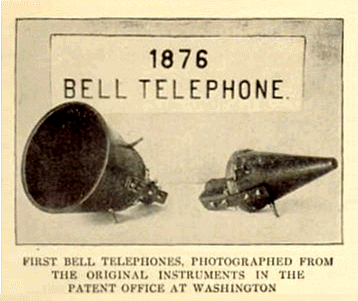 |
Telephone, who does not have one ? But what is an
obviousness today, was right in the beginning nothing but a lucky
find in margin of work made by Alexander Graham Bell, who sought to
return hearing to a deaf person. This work, where he
sought to capture the sound and to transform it into eclectic current
fluctuations, led to this sentence where it asks his assistant to
come, who came towards him and said to him that it had clearly
understood his master, when he awaited the call in the apparatus.
It was thus on March 10, 1876, in Boston, in Massachusetts, that this
handcrafted apparatus produced by Alexander Graham Bell, was baptized
vibraphone, with which he succeeds for the first time to remotely
transmit the voice of his inventor. Professor of
elocution for deaf people, Bell is interested in vocal physiology and
telegraphy. To 29 years, his research on the vocal
transmission by vibration results to be successfully.
With some associates, he founds the Bell Telephone Company and
markets the first telephones. Note that Graham Bell
finished marrying the girl whom he was supposed to return its
hearing, however without returning hearing to her.
Vaccination and sterilization, Louis Pasteur.
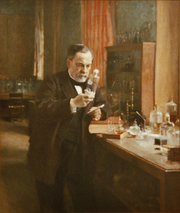 |
Nobody, who goes today to the supermarket, to buy his small yoghurt
pots, a package of vanilla cream , bread rods, these milk cartons,
wine a bottle and some cheese, still remind this doctor of the 19th
century, Louis Pasteur. Even if Pasteur is known to have
invented a remedy against rabies, it is him that we deserve much of
what relates to food such as it is presented to day.
Because it is well him who had shown that these very small beings,
now known under the name bacteria, and other moulds, even known at
the time were at the origin of the majority of the diseases, and
moulds of food. He had also shown that the life did not
appeared systematically, as they believed at his time.
But which what they believed at that time to be the origin of
nothing, was nothing but an invisible world. It is him
who is at the origin of the fermentation methods as they are used
today. Because it is well him who had developed the
system to sterilize food and to sow it with a fermentation agent of
pure state. A second invention of him was to infect a
person with a deliberately weakened infectious agent, which we know
today under the name vaccination. Most famous of these
vaccinations was that of rabies.
Transmission of messages, Samuel Morse
and Guglielmo Marconi.
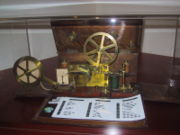 |
Samuel Finley Breese Morse, more known under the name of Samuel
Morse, was an American, painter, inventor of the electric telegraph
and the correspônding alphabet which bear its name.
He was born on April 27, 1791 in Charlestown, Massachusetts, and died
on April 2, 1872 in New York. Guglielmo Marconi (April
25, 1874 to July 20, 1937) was an Italian physicist and businessman.
Based on the discoveries of Hertz, Popov, Branly and
Lodge, he carries out many experiments on the propagation of the
Hertzian waves. Like Samuel Morse for the electric
telegraph, he is the true promoter of the transmissions by radio or
TSF (French ; means wireless transmission, saying literally :
“Télégraphie
Sans Fil”). The first communication took
place on May 1897 in Morse with more than 13 km between Lavernock
(Wales) and Brean (England) over the Bristol-board Channel.
On return in Italy in July 1897, the Italian royal navy allows him to
carry out tests between a fixed transmitter located in the arsenal of
San Bartolomeo with Spezia (Italy) and a receiver on board the tug
boat San Martino. The antenna used was 34 m length.
A range of 18 km was reached. Creation of the “Wireless
Telegraph and Signal Company”.
The steam engine, James Watt.
The importance of the invention of the steam engine by James Watt
does not leave any doubt. Because this invention had
marked the beginning of the industrial era. Even if Mr
James Watt had not completely invented the steam engine on its own,
it is well him who had made, starting from the steam engines of
Savery or Newcomen, used formerly as long as pumps in the English
mines, a steam engine able to function in a stable and autonomous
way.
The steam engines of Savery or Newcomen posed the same problem of
output and continuity in the movement. At the end of
some cycles of operation the machines stopped. It was
necessary to stop them and restart them. In order to
improve the power and the regularity of its steam engine, James Watt
had the idea to transform these machines "single cycle" by
machines "double cycle" and bring some of its inventions
there:
The wheel
The centrifugal governor
The
distributor slide valve of the vapor
The beam with its articulated
parallelogram
The external condenser
The four-stroke engine, Nikolaus Otto.
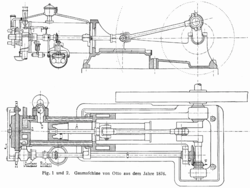 |
Nikolaus August Otto (Holzhausen June 14, 1832 - Cologne January 28,
1891) is a German industrial inventor, and Co-inventor of the
internal combustion engine in 1867. Founder of the
industrial company Deutz AG (IVECO since 1975). (Father of Gustav
Otto, Co founder of BMW with Karl Rapp in 1917) In its youth he
started to try out the gas engines, and in 1864 together with two
friends he founded in Cologne his own company, N.A. Otto and Co,
which was the first to manufacture internal combustion engines.
This company, which moved in 1867 to Deutz on other bank of the
Rhine, still exists today under the name of Deutz AG.
His first atmospheric engine was built in May 1867. Five
years later he was joined by Gottlieb Daimler and Wilhelm Maybach and
together they produced the engine with four-stroke cycle or Otto
cycle (this was the start of Daimler and Mercedes-Benz industries)
Descibed initially in 1876, the travel of the piston form a top to
bottom movement in a cylinder. The patent of Otto was
canceled in 1886 after it was discovered that another inventor,
Alphonse Beau of Rochas had already described in 1862 the principle
of the four-stroke cycle in a booklet with private diffusion, but of
which, however, he had deposited the patent. In 1911 his
son Gustav Otto 28 years old, founds the company "Gustav Otto
Flugmaschinenfabrikun", factory of plane engines of which he is
pioneer in Munich in Bavaria on the basis of engine invented by his
father. Its company becomes BMW on July 21, 1917 after
fusion with the company "Rapp Motoren Werke" of Karl Rapp.
Tire with tire tube, John Boyd Dunlop,
then Édouard and André Michelin.
 |
John Boyd Dunlop, who lived from 1840 to 1921, is the Scottish
inventor who had invented the tire tube, and which had founded the
company of tires which bears its name. He was born on
February 5, 1840 in a farm in Dreghorn, in the Scottish area of North
Ayrshire. He makes then studies of veterinary surgeon at
the University of Edinburgh then follows this occupation during
nearly 10 years at his place, before leaving into 1867 for Belfast,
to Ireland. Meanwhile, in 1839 Charles Goodyear deposits
the patent of the vulcanization of rubber, and in 1845 the Scot
Robert William Thomson, invents the first tire starting from rubber
binding stuck on a rim, of which it deposits a patent in 1846.
Alas, the lack of robustness of the tire and the impossibility of
finding a practical application to his invention, make that William
Thomson gives up his patent of the “wheel of air”.
John Boyd Dunlop has in 1887, without apparently knowing the
invention of W. Thomson, the idea to surround the wooden bicycle
wheels of his son with rubber tubes filled of air in order to improve
comfort of it, the noise, speed and adherence on road.
His tire has an immediate success in the bicycle world, the great
champions of the time use it successfully. John Boyd
Dunlop deposits the patent of the tire with air with valve on
December 7, 1888. But the invention of Dunlop does not
allow easy repair in the event of puncture. It was in
1891 that Édouard and André Michelin invented the first
dismountable tires with a tire tube. In margin of the
bicycle, the invention of Dunlop (and technical innovations of the
Michelin brothers) arrive at one crucial period of the development of
the automobile and especially of the motor cycle, his invention finds
thus an immediate application. Dunlop yields his patent
to William Harvey Of Cros against 1'500 shares of the lately created
company. Finally he does not make great fortune of his
invention. John Boyd Dunlop dies on October 23, 1921 in
Dublin.
The train, Richard Trevithick
(English).
We owe the invention of the railroad to Richard Trevithick (English)
It is him who developed the first genuine engine for
passenger transport, whose first voyage had taken place on February
22, 1804. The first commercial line in France was "Paris
- Pecq", then Saint-Germain-en-Laye.
Roads of rails, called Wagonways, were used in Germany as of 1550.
These primitive enclosed roads were made up of rails of wood, on
which the horse-drawn carriages could move with a greater facility
than on dirtiness covered roads. The "Wagonways"
were the beginnings of the modern railroads. Little by
little from 1776 onwards, iron had started to replace wood in the
rails, and for the wheels of the carriages. The
"Wagonways" were gradually transformed into trams, and were
diffused all over Europe. The horses always provided the
essential power of traction. It was into 1789, that an
English, William Jessup had designed the first carriages with the
wheels with flask. The support was a groove which made
it possible to the wheels to improve the catch with the rail, this
was an important design, which had been deferred to the posterior
engines. The invention of the vapor engine was critical
with the invention of the modern railroad. It was in
1803, that a man named Samuel Homfray, had decided to begin the
development of a steamer-actuated vehicle, to replace the horse-drawn
vehicles on the trams. It is Richard Trevithick,
(1771-1833) who had built this vehicle, the first tram with steam
engine. It was on February 22, 1804, when the engine
transported a load of 10 tons iron, 70 men, and of five additional
carriages out on the 14 kilometers between the Ironwork with at
Stylo-y-Darron and the town of Merthyr Tydfil, Wales, at the bottom
of the valley called Abercynnon. The trip had taken
approximately two hours. The english Jules Griffiths was
the first one to register a patent in 1 821 for a road engine for
passengers. It was in September 1825, that the company
"Stockton & Darlington Railroad Company" had begun its
activity as las the first railroad company. They then
started to program to transport goods, and passengers, on a regular
interval, and this using the engines designed by the English
inventor, George Stephenson. The engine of Stephenson
drew six cars charged with coal, and 21 private cars with 450
passengers at a speed of fourteen kilometers per hour.
Sewers, town of London.
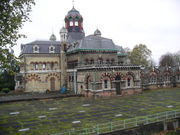 |
|
Photograph: Old station of pumping
|
The sewers of London (the United Kingdom) represents part of the
network of water treatment worn of the British
capital. Built during second half of the XIXth
century based on the projects of British engineer Joseph Bazalgette,
this network contributed to the cleansing of the city and allowed
eliminate the cholera.
At the beginning of the XIXth century, the Thames is was
an open sewer which collects all worn water of London.
The invention and the use of the water closet makes the houses more
hygienic but all is evacuated by the networks originally intended for
rainwater. A new disease, the cholera, appears and other
diseases like dysentery and the typhoid fever are spread.
In August 1849, Joseph Bazalgette is named geometrician assistant in
Metropolitan Sewer Commission. Edwin Shadwek and William
Farck think as a number of their contemporaries, that the cholera is
transported by miasmas, i.e. the odors are responsible for the
diseases. They thus decide cleaning of the sewers
towards the rivers.
The epidemic finishes in winter 1849 without nobody knows the origin
of the disease. John Snow expresses a doubt on the
theory of miasmas. In 1853, the disease reappears.
For Snow, it appears whereas the disease (cholera) is propagated by
the drinking water.
Preliminary
drafts:
Joseph Bazalgette is named in
1856 in the metropolitan council of work and must build a new
sewerage system. He calculates that the slope necessary
is 40 centimeters to one kilometer. This will allow a
sufficient flow while avoiding prematurely using the drains by a too
important speed. He bases its plans on the idea to
convey the refuse in the estuary of the Thames, with gravity, a tank,
and a outfall. His plans must take account of the
importance of the tide which it uses to cause the mechanical
extraction of the waste accumulated in the final tank.
His plans require 300'000'000 bricks, more than 150 km of 3 meters
height tunnel and of oval form for the resistance. The
whole of the project envisages the construction of two networks
distinct located on both sides from the Thames. The
plans were redrawn five times, and rejected five times of
continuation by the authorities.
Work
of the sewers:
The contamination is so
strong, that during the summer 1858 the notable ones flee the city.
The air of the Parliament is also contaminated.
The members of Parliament sign then the bill and give 3'000 000
British pounds to begin work. This work must allow the
construction of 1'750 km of tunnels in order to convey
140'000'000'000 of liters of refuse (140 billion) per annum.
For each tunnel, work consists to trench, to build the drain (out of
bricks), and to cover with ground. The solidity of the
work depends on materials used. Bricks being maintained
with cement. This last was selected according to its
properties of resistance. Portland cement is selected;
this was then about a new material. One of its principal
properties is to harden in contact with water. But it
suffers from a difficult proportioning. For this reason,
a sample of each botch of cement is controlled (form of quality
control). Work was stopped at the end of one year
because of a strike of the masons who claim 6 shillings per day
(worked) instead of five. During work, accidents occur:
A gas pipeline is bored, which causes an explosion and a death.
The workmen of the subway dig too much close to the sewers, the
subway is then flooded. In the south of London,
quantities of ground and wood break down. On the 6
workmen buried alive by the accident, 3 are found alive, 2 died and 1
disappeared without remainder. But, less than ten
accidents occur during all the duration of the work. In
order to look after its image, he invited journalists at the
connection of two sections of conduit. One of the
principal elements of the work is the tunnel of Woolwich, which must
convey the used water towards the pumping station. This
pumping station contains the largest pump ever manufactured, 4 steam
engines are installed there. They make it possible to
pump from 7 meters of depth, and store the water used in a tank.
The station was inaugurated by the Prince of Wales.
End
of work:
3 months after the
inauguration, the cholera reappeared. A water tank
seemed to be contaminated, whereas water was to be filtered.
Eels were found in the tank. The presence of these eels
proved that not filtered water contaminated by the refuse was brought
in the tank. Since the end of work, the cholera never
reappeared in London. On July 26, 1 867, in spite of
spectacular precipitations, the sewers run out all water.
Protocol HTML and Internet, CERN.
 |
Opposite with the beliefs, the Internet, and above all, its protocol
of document description in hypertext, was not an invention of the
industrial groups, and it was not an invention of one of associations
of standardization. The Internet and HTML protocol was
born at CERN the European Center
for Nuclear Research, in Geneva.
This center is not, contrary that what its name could make you
believe, an institution to manufacture bombs, nor does it manufacture
either equipment for nuclear thermal power stations, but is a center
where we try to recreate the conditions of the Big-bang, for better
sunderstanding the nature of the matter. It was natural
that the scientists sought to share the results of their research
between them. Therefore a system and a protocol of
document sharing were developed. Since, this system was
taken over by the majority of the research centers, of the
universities, and other organizations, and made its way since.
This protocol and system underwent a multiple of adaptations since,
to have become the Internet of today.
The art of books printing, Johannes Gutenberg.
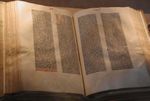 |
Johannes Gensfleisch say Gutenberg (Literally:
Goodmountain ) - was born about 1400 in Mainz, Germany.
Innovator in the use of the mobile characters, he is recognized like
the first printer to have used the mobile metal characters for the
printing of a book. His invention will revolutionize the
traditional methods of book production, in spite of that his
existence was difficult, ripped of by his associate - Fust or Fuchs -
he will be saved of misery by Adolphe II of Nassau who granted him a
life pension and the title of gentleman. Johannes is the
3rd child of a rich family Friele Gensfleisch zur Laden.
His date of birth cannot be established precisely.
Between 1434 and 1444 he can be found in Strasbourg where he gets his
training to become goldsmith. The bases of its future
work - mixing and the mastering of alloys - will enable him to
conceive resisting and ad infinitum reproducible block letters.
His residence between on March 12, 1444 and on October 17, 1448 is
unknown (perhaps Netherlands). For this year he has been
in Mainz (documented on October 17, 1448). Since the
beginning of 1450 he maintains a financial relation with J. Fust, who
gave him 1550 guilder. Gutenberg pawned his tool and
took Fust like associate. In 1450, Gutenberg found the
way to production engineering of exchangeable and equal (alloy of
lead, iron, tin and antimony the types out of metal) metal types with
the help of cut stamps of iron, matrices of copper and an instrument
to be cast. Gutenberg died on February 3, 1468 in his
birthplace.
The computer, mechanical and electronic calculation,
Babbage, Bool and Von Neumann.
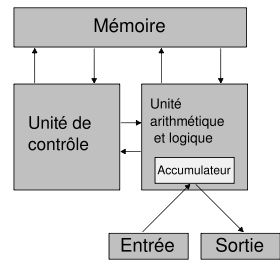 |
It was not, contrary to the beliefs, Blaise Pascal, who would have
invented the computer, we must allot to him the invention of the
calculating machine, considering that the Chinese counting frame was
only an assistance, and did not have, contrary to the machine of
Blaise Pascal a of function "calculation". The
machine of Pascal, on the other hand, cannot be calcified to be the
first computer, because it was neither able to store data, neither
store the results, nor store the operations to be made.
The first which had developed such a prototype, was the English
Babbage, in the middle of the XIXth century.
Mr Babbage had well, after having tested successfully a prototype,
having drawn a concept which corresponded to a computer, but it was
necessary to await the beginning of the XXIth century
before a team of a university could build the machine.
His concept resembles curiously the model establish by John Von
Neuman, one century later !
George Bool published in 1839 his first study in Cambridge
Mathematical Journal. This publication and the support
which it obtained from the circle of the algebraist
of Cambridge makes it him possible to become gradually more essential
like an important personality of the world of mathematics.
In 1844, after the publication of a report of analysis in
Philosophical Transactions, the Royal Society decrees a medal to him.
It is the beginning of a series of work posing the bases
of what one will name later the Boolean algebra. In 1847
"Mathematical Analysis of Logic", then "An
investigation into the laws of thought", on which are founded
the mathematical theories of logic and probabilities in 1854.
George Boole develops a new form of logic to with it, at the same
time symbolic system and mathematics. The goal: to
translate ideas and concepts into equations, to apply certain laws to
them and to retranslate the result in logical terms. For
that, he creates a binary algebra accepting only two numerical
values: 0 and 1. This algebra is defined by the data of
a unit E (nonempty) provided with two laws of internal composition
(AND and OR) satisfying a certain number of properties
(commutation..., distributivity...). The work of Boole,
even if it is theoretical, will find the applications in various
fields as the information processing systems, the theory of
probability, electric circuits and telephones, etc.
This thanks to scientists like Pierce, Frege, Russel, Turing and
Shannon.
The computer of today is primarily based on work of George Bool and
John Von Neuman, who showed the construction of the first computer,
Z3, a programmable but still mechanical machine, in 1 941.
This first programmable machine, was quickly followed by the British
computer “Colossus”,
which was followed in its turn by the ENIAC, which used, just like
“Colossus”,
the vacuum tubes. The ENIAC, acronym of Electronic
Numerical Integrator To analyze and Compute, is the first entirely
electronic computer built to be Turing-complete. It could be
reprogrammed to solve a great number of calculative problems.
Links
News
C.E.R.N.
NASA
M.I.T
Astronomy
IFREMER
Cousteau
|









